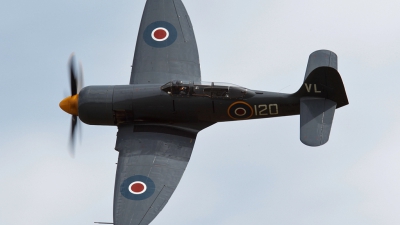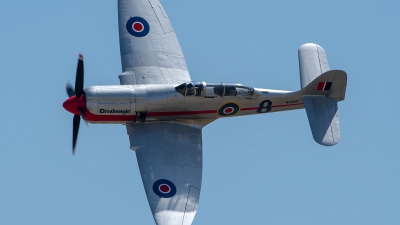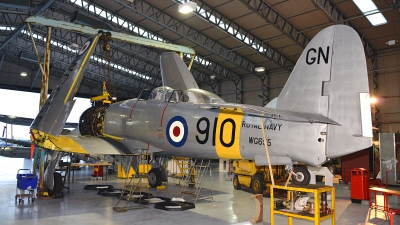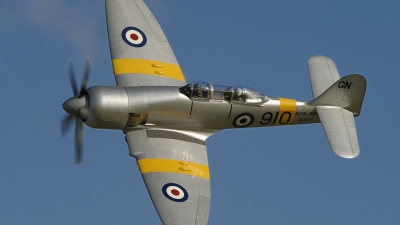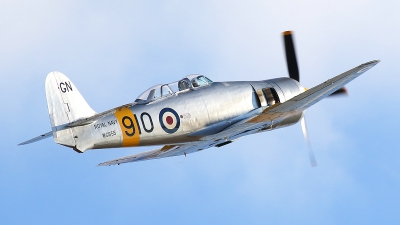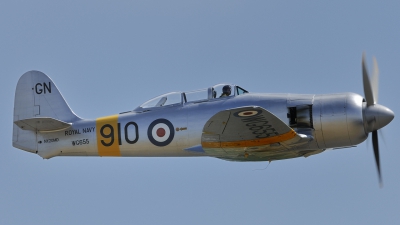Hawker Sea Fury T20 Aircraft Data
The Hawker Sea Fury was to become the Fleet Air Arm's last piston-engined fighter. Development had started in 1943, for the Royal Air Force (RAF), intended as a successor of their highly successful Typhoon and Tempest fighters.
During April 1944 production contracts were placed for 200 Fury I aircraft for the RAF and an equal number of Sea Fury aircraft for the Fleet Air Arm, of which 100 were to be built by Boulton Paul Aircraft Ltd. A few months later, with the Allied armies gaining a strong foothold in France after the D-Day landings and with the end of the World War II in Europe in sight, the production order for the RAF Fury was cancelled. The Royal Navy however considered the aircraft a suitable replacement for its ageing carrier borne fighters and pressed for continuation of the development of the Sea Fury.
At a relatively late stadium a two-seat training version of the Sea Fury entered production. When negotiating the purchase of Furies for their Air Force, the Iraqi government had enquired on the feasibility of a two-seat trainer/conversion aircraft to assist transition to the high performance Hawker fighter. The British Admiralty also realised this potential and an order for one prototype to Specification N.19/47 was ordered on 23 June 1948. Some time earlier, the prototype originally ordered by the Iraqi Government (with serial 264) was diverted to the Royal Navy. The aircraft, VX818, was built at Kingston and was completed at Langley, making her first flight there on 15 January 1948. Handling trials followed by C Squadron, Aeroplane&Armament Experimental Establishment (A&AEE) at Boscombe Down in March 1948. During one of these flights the rear cockpit canopy collapsed, as it turned out due to excessive aerodynamic forces. As a remedy a perspex 'tunnel' connecting the two cockpits was added. This feature became standard on all Fleet Air Arm T.20s. The two-seat T.61s for the Pakistan Air Force and the two Fury IDT two-seat aircraft for the Iraqi Air Force still featured the earlier two-cockpit lay out. In January 1952 VX818 was delivered to the Empire Test Pilots School (ETPS) at Boscombe. An engine failure on 22 June 1964 resulted in a forced landing some 11 miles from her base. On landing VX818 desintegrated.
Dimensions of the T.20 equalled those of the FB.11. The addition of an extra cockpit for the instructor necessitated the relocation of equipment. Therefore two of the 20mm cannon were dispensed with, to allow the installation of oygen bottles (in the port wing) and additional avionics in the starboard wing. Another feature of the (FAA) T.20 was the periscopic sight mounted over the 'tunnel' between the two cockpits. Often referred to as the 'tripod', the sight was actually mounted on four legs and allowed the instructor to monitor his pupils main flight instruments and gun sight. As on the FB.11, the T.20 could carry two 90-Imp Gallon (409 litres) fuel tanks as well as the armament of the fighter-bomber.
The T.20 also had provision to carry 'Rato-bottles' for rocket-assisted take-off, but these were never seen being used. Not intented for carrier operations, the T.20 had no tail hook. Contrary to the T.20 prototype, all production T.20s featured a fixed tail wheel. In more recent years however, some warbird operators opted their T.20 to have the tail wheel retractable, as in the TFC's example WG655. This machine had the characteristic 'tripod' removed. Unfortunately WG655 was lost in an accident on 4 August 2020, when pilot Eskil Amdal had to make a forced landing near Harston in Cambridgeshire. He and 'navigator' Dave Unwin escaped with injuries.
Deliveries of the T.20 to the Fleet Air Arm began in February 1950.
Sea Fury T.20 production and serials
The manufacture of the T.20 was covered by 5 contract blocks and totalled 60 production aircraft and one prototype:
VX818 (1 a/c), the T.20 prototype.
VX280-292, VX297-310 (27 a/c).
VZ345-355, VZ363-372 (21 a/c).
WE820-826 (7 a/c).
WG652-656 (5 a/c).
During April 1944 production contracts were placed for 200 Fury I aircraft for the RAF and an equal number of Sea Fury aircraft for the Fleet Air Arm, of which 100 were to be built by Boulton Paul Aircraft Ltd. A few months later, with the Allied armies gaining a strong foothold in France after the D-Day landings and with the end of the World War II in Europe in sight, the production order for the RAF Fury was cancelled. The Royal Navy however considered the aircraft a suitable replacement for its ageing carrier borne fighters and pressed for continuation of the development of the Sea Fury.
At a relatively late stadium a two-seat training version of the Sea Fury entered production. When negotiating the purchase of Furies for their Air Force, the Iraqi government had enquired on the feasibility of a two-seat trainer/conversion aircraft to assist transition to the high performance Hawker fighter. The British Admiralty also realised this potential and an order for one prototype to Specification N.19/47 was ordered on 23 June 1948. Some time earlier, the prototype originally ordered by the Iraqi Government (with serial 264) was diverted to the Royal Navy. The aircraft, VX818, was built at Kingston and was completed at Langley, making her first flight there on 15 January 1948. Handling trials followed by C Squadron, Aeroplane&Armament Experimental Establishment (A&AEE) at Boscombe Down in March 1948. During one of these flights the rear cockpit canopy collapsed, as it turned out due to excessive aerodynamic forces. As a remedy a perspex 'tunnel' connecting the two cockpits was added. This feature became standard on all Fleet Air Arm T.20s. The two-seat T.61s for the Pakistan Air Force and the two Fury IDT two-seat aircraft for the Iraqi Air Force still featured the earlier two-cockpit lay out. In January 1952 VX818 was delivered to the Empire Test Pilots School (ETPS) at Boscombe. An engine failure on 22 June 1964 resulted in a forced landing some 11 miles from her base. On landing VX818 desintegrated.
Dimensions of the T.20 equalled those of the FB.11. The addition of an extra cockpit for the instructor necessitated the relocation of equipment. Therefore two of the 20mm cannon were dispensed with, to allow the installation of oygen bottles (in the port wing) and additional avionics in the starboard wing. Another feature of the (FAA) T.20 was the periscopic sight mounted over the 'tunnel' between the two cockpits. Often referred to as the 'tripod', the sight was actually mounted on four legs and allowed the instructor to monitor his pupils main flight instruments and gun sight. As on the FB.11, the T.20 could carry two 90-Imp Gallon (409 litres) fuel tanks as well as the armament of the fighter-bomber.
The T.20 also had provision to carry 'Rato-bottles' for rocket-assisted take-off, but these were never seen being used. Not intented for carrier operations, the T.20 had no tail hook. Contrary to the T.20 prototype, all production T.20s featured a fixed tail wheel. In more recent years however, some warbird operators opted their T.20 to have the tail wheel retractable, as in the TFC's example WG655. This machine had the characteristic 'tripod' removed. Unfortunately WG655 was lost in an accident on 4 August 2020, when pilot Eskil Amdal had to make a forced landing near Harston in Cambridgeshire. He and 'navigator' Dave Unwin escaped with injuries.
Deliveries of the T.20 to the Fleet Air Arm began in February 1950.
Sea Fury T.20 production and serials
The manufacture of the T.20 was covered by 5 contract blocks and totalled 60 production aircraft and one prototype:
VX818 (1 a/c), the T.20 prototype.
VX280-292, VX297-310 (27 a/c).
VZ345-355, VZ363-372 (21 a/c).
WE820-826 (7 a/c).
WG652-656 (5 a/c).
- Country of Origin: United Kingdom
- First Flight: 15 January 1948
- Initial Service Date: February 1950
- No. Built: 61
- No. In Service: 0
- No. of Hardpoints: 4
- Crew: 2
Power:
Bristol Centaurus XVIII at 2,480 hp
Weapons:
Two 20mm Hispano Mk.5 cannon with 145 rounds each.
Eight 60lb 3 inch Rocket Projectiles or four 180lb Triplex RPs or
two 1,000lb or 500 lb bombs or napalm canisters.
Eight 60lb 3 inch Rocket Projectiles or four 180lb Triplex RPs or
two 1,000lb or 500 lb bombs or napalm canisters.
Dimensions:
| Length: | 34 ft 8 in. |
| Wing Span: | 34 ft 4¾ in. |
| Wing Area: | 280 sq.ft |
| Height: | 15 ft 10 in. |
| Empty Weight: | 8,700 lbs |
| Max. Weight: | 11,930 lbs |
| Internal Fuel: | 1,384 lbs |
Performance:
| Max. Speed: | 445 mph |
| Service Ceiling: | 35,600 ft. |
| Normal Range: | 704 nm |
| Max. Range: | 1,416 nm |
Operators:
AustraliaAlthough the Royal Australian Navy received 99 Sea Fury FB.11s, diverted from Royal Navy contracts, the RAN acquired no two-seat aircraft.
Burma (now Myanmar)
The Burmese Air Force received 18 Sea Fury FB.11s from the Fleet Air Arm, as well as three ex-FAA T.20s for conversion and continuation training:
UB451 (ex FAA T.20 VZ368), delivered in December 1957.
UB452 (ex FAA T.20 VX292), delivered in February 1958.
UB453 (ex FAA T.20 VZ354), delivered in April 1958.
Canada
Initially Canada obtained 35 FB.11s from Royal Navy Fleet Air Arm production for use by two Royal Canadian Navy units. Like the RAN, the RCN acquired no two-seat T.20s.
Cuba
The Fuerza Aérea del Ejército de Cuba obtained 15 ex-FAA Sea Fury FB.11s as well as two T.20s. The two-seaters were former FAA VZ349 and VZ363. Very little is known about their service in Cuba. There is even doubt, that the second T.20 (VZ363) actually arrived on the island.
Germany
The Deutsche Luftfahrtberatungsdienst (DLB) at Lübeck-Blankensee operated 16 Sea Fury T.20s and one FB.11 between 1958 and the early 1970s. The T.20 aircraft were modified by Hawkers for target towing duties. These modified aircraft are usually referred to as Sea Fury T.20S. Some older sources identify the modification as TT.20 or even TT.20S.
Iraq
Apart from 30 new-built single-seat aircraft, known as Iraqi Single Seaters (ISS), the 'Al Quwwa al Jawwiya al Iraqiya' (the Iraqi Air Force') placed an additional order for 25 aircraft on 21 July 1951, of which the first 15 were new-built, with the other 10 coming from Fleet Air Arm stocks.
For conversion training, the Iraqi Government had also ordered the design a two-seat version and had expressed an initial interest in four trainer aircraft. The prototype Iraq Dual Trainer (IDT) IDT-4, with Iraqi Air Force serial 264 allocated, was built at Kingston and completed at Langley, but eventually transferred to the Royal Navy to become T.20 prototype VX818. Of the remaining first three Iraqi duals only two were delivered: '261' (IDT-1) on 24 February 1948 and '263' (IDT-3) on 21 May 1948. For some reason IDT-2 was redirected to Pakistan and became Fury T.61 serial 'K850'.
In July 1952, as part of an order for 15 new-build Fury ISS and 10 refurbished ex-FAA Sea Fury FB.11s, another three dual-seat trainers were purchased. These were also refurbished aircraft and were delivered in the course of 1952:
'327' (ex FAA T.20 VX367)
'328' (ex FAA T.20 VX347)
'329' (ex FAA T.20 VZ348)
Pakistan
In 1953-54 the Pakistani Air Force received five refurbished Fleet Air Arm Sea Fury FB.11s to complement an earlier order of 87 Sea Fury FB.60 aircraft. These Sea Furies equipped three front line squadrons: No. 5 Squadron, No.9 Squadron
and No.14 Squadrons.In addition Pakistan received five T.61 two-seat aircraft. These aircraft were serialled K850 to K854, with 'K850' being the former Fury IDT-2, originally intended for delivery to the Iraqi Air Force as '262'.
All five T.61s featured the early two-canopy lay-out.
United Kingdom
The Royal Navy's Fleet Air Arm front line units operating the Sea Fury FB.11 made use of a T.20. The use of a two-seater (at their shore bases) of following units is confirmed:
No.801 Squadron
No.802 Squadron
No.810 Squadron
No.809 Squadron, a Sea Hornet unit, operated a T.20 between November 1951 until January 1952.
Second-line FAA squadrons operating the T.20:
No.703 Squadron
No.736 Squadron
No.738 Squadron
No.759 Squadron
No.766 Squadron
No.771 Squadron
No.781 Squadron
No.782 Squadron
No.799 Squadron
These units of the Royal Naval Volunteer Reserve had the T.20 on strength:
No.1830 Squadron
No.1831 Squadron
No.1832 Squadron
No.1833 Squadron
No.1834 Squadron
No.1832A/8135 Squadron
No.1832B/8135 Squadron
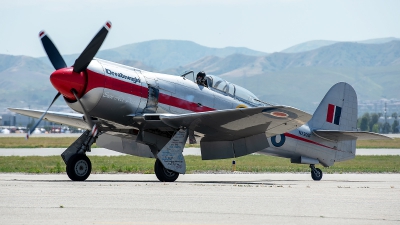
 Random great photos of the Hawker Sea Fury T20:
Random great photos of the Hawker Sea Fury T20:
